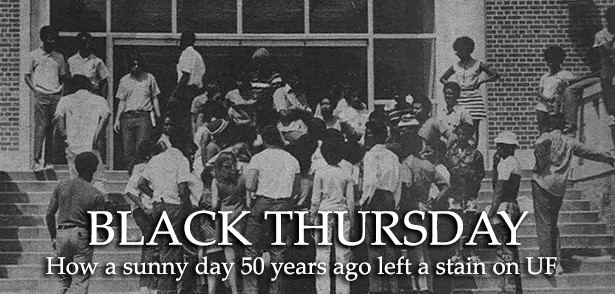By Sarah Breske | April 15, 2021
Procrastinating Americans woke up on that April day knowing their taxes were due. President Richard Nixon had just eased a trade embargo on China. The Supreme Court was deciding whether busing was a constitutional means to desegregate American schools. In a few months, the voting age would be lowered to 18, and The New York Times would expose government secrets by publishing the Pentagon Papers, making the Vietnam War even more unpopular with the public. In Florida, Walt Disney World would open its doors, forever changing the tourism landscape of the state.
Thirteen years had passed since the University of Florida admitted its first Black student. Eight years had passed since Martin Luther King Jr. delivered his “I Have a Dream” speech on the Mall in Washington; seven since Lyndon B. Johnson signed the landmark Civil Rights Act; and three since King was assassinated.
The struggle for racial equality had only just begun. Across America, and here in Gainesville.
The sun rose high and bright over the UF campus on April 15, 1971. But quickly, it would turn into a dark day, a stain on the university’s history.
Adrift in a sea of whiteness
Sulmarie Duncan was only 5 when the University of Florida began to desegregate. She watched from afar as it went through the trial and error of fitting Black youth into the student body. Duncan had attended the all-Black Lincoln High School in its last year of existence before integration laws forced Alachua County to relocate Black students and teachers into white high schools. And at 17, a week after graduation in the summer of 1970, she started classes at the predominantly white UF campus.
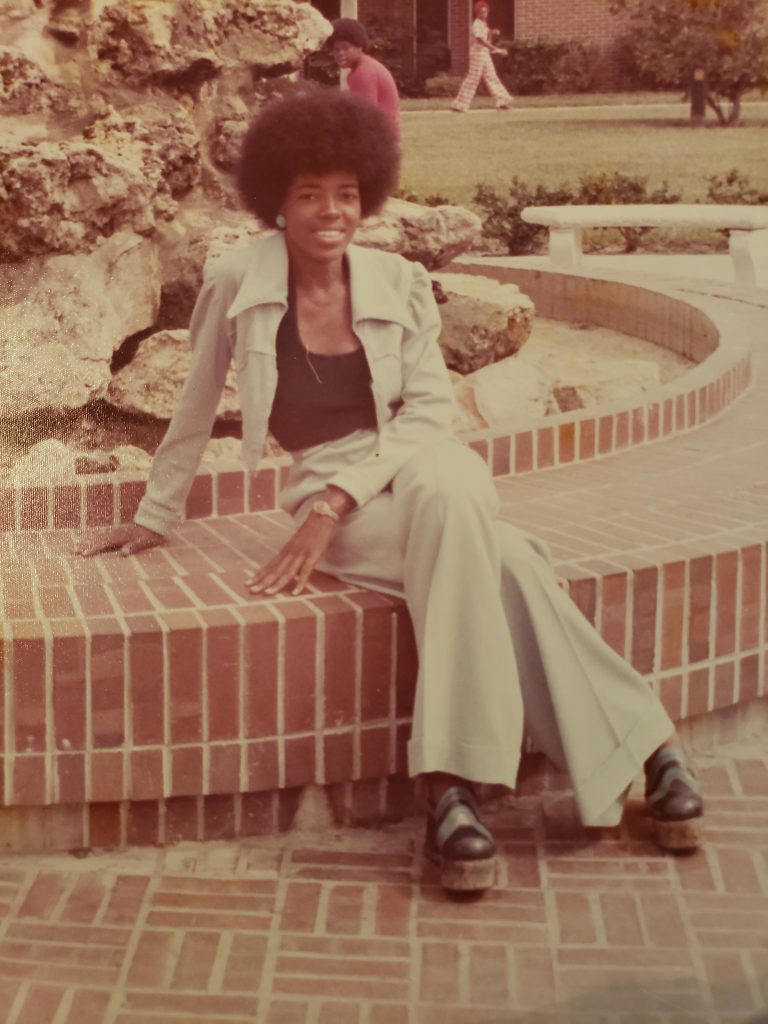
She was one of only 343 Black students among 20,000 white students. For all practical purposes, the campus was segregated; not many interracial interactions occurred outside the classrooms. Black students often felt adrift in a sea of whiteness. There were few Black professors and the only other people who looked like them were the custodial workers who cleaned the classrooms, bathrooms, dining halls and dorms.
Black students felt alienated. Unwanted, even. Duncan could count on one hand the number of white students she knew by name.
The majority of Black students were housed in one small block of dorms — girls in East Hall, boys in South Hall. Below one of those halls was an unfinished, unfurnished room — the basement.
The room was made of concrete, devoid of any personality, save for the lively souls that would fill it frequently for parties and meetings. But for all its abandoned simplicity, it was their space, the only space Black students had been given to gather, speak freely and mix, without judgment and scornful eyes. It was their sanctuary, where they could figure out what it meant to be young and Black at a white university in a period of unrest and upheaval across America.
Duncan, who grew up in Gainesville, took comfort in knowing the city so well and pride in being able to help her new friends navigate its inner workings. She often did this with other Gainesville natives, some she knew from high school or middle school. They would take newbies to the cool hangout spots in the good parts of town where it was safe for young Black men and women to go.
Despite being an introvert, Duncan enjoyed being a part of a community. These were her people. But she wanted more. They all did.
The UF administration, they believed, had not done enough to create an inclusive atmosphere; to make Black students feel welcome.
Duncan had decided to major in psychology, but still finishing her general course requirements. It was to one of these classes she was headed on the morning of April 15, 1971.
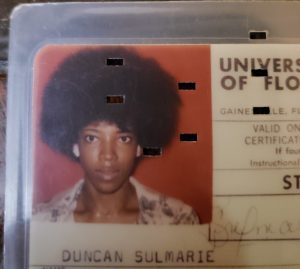
She fluffed her Angela Davis Afro, slipped on her high heels and strutted out of her small room in East Hall for her morning class. She then met up with a friend, Angela Hughes. The two women had a little time in between classes, so they took a detour down 13th Street. They proceeded up vast steps to the main doors of Tigert Hall, which housed the office of UF President Stephen O’Connell. They then walked through the entrance, grand enough to make anyone feel small.
Duncan knew the plan for that day. It had been made the night before in that desolate basement room that she frequented. And it was already in motion by the time she and Hughes arrived.
Demands for change
The fledgling Black Student Union at UF had been discussing for a while the changes they sought from the administration. On this April day, they marched to Tigert Hall with six demands in hand. Among them: Recruit more Black students as well as faculty, open the Institute of Black Culture and treat all the “brothers and sisters” of UF better.
Clarence Martin, the president of the Black Student Union, had already asked the receptionist at O’Connell’s office for a meeting. When she insisted he wasn’t available, 66 Black students marched in, fell to the floor, sat down and refused to leave. They would wait as long as it took to get O’Connell’s attention.
O’Connell had no intention of listening to the crowd of Black students amassing at Tigert Hall. He did not meet with the first wave of students who entered his office on that April day. He did not listen to their demands that had been carefully crafted the night before. Instead, he threatened to suspend them all unless they vacated the premises immediately.
They viewed O’Connell as a typical white product of the Jim Crow South. He had been a part of the majority on the Florida Supreme Court when it upheld a decision to deny a black man admission to UF in 1949 on the grounds that the prospective student was “a potential disruptive influence.”
O’Connell had attended segregated schools all his life, including UF, and had worked as a lawyer in a segregated judicial system. He served as chief justice of the all-white Florida Supreme Court. In his fifth year as university president, he was still a member of the whites-only Gainesville Country Club.
Students of color saw O’Connell as the embodiment of Southern white conservatism. Of racism.
Below: Listen to a version of this story by Meleah Lyden on our daily podcast.
O’Connell had no intention of listening to the crowd of Black students amassing at Tigert Hall. He did not meet with the first wave of students who entered his office on that April day. He did not listen to the demands they had carefully crafted the night before. Instead, he threatened to suspend them all unless they vacated the premises immediately.
A storm brews in the halls of power
Duncan and her friend were among a second group of students who attempted a face-to-face meeting that day with O’Connell. They plopped themselves down in Tigert Hall as part of the sit-in. But O’Connell would not budge and the students grew increasingly disgruntled.
Near the door stood Sam Taylor, a Black Student Union member who was running for student government office. He did not intend to be there that day. He had been campaigning by the College of Architecture just an hour before when he noticed a crowd of Black students heading toward Tigert. When he found out about their demands, he couldn’t help but follow them.
But O’Connell’s patience was wearing thin. He kicked out the second wave of students just as he did the first. Suddenly, Taylor found himself trying to persuade O’Connell to listen. Just hear them out, he told the university president.
O’Connell’s nose looked slightly squashed and crooked from his days of boxing at the university. It added to his character a sort of blatant toughness that, for the most part, he hid behind his politically smoothened facade. This could be quickly overlooked during a simple press conference or presidential lunch, but on this day, it only made his anger more visible.
He called the student demands “irrational” and “insincere.”
But the Black students were determined. They were not going to give up so easily for something that was at the very core of their university experience — inclusion, respect.
So they went in again. They made a third effort to speak with O’Connell. This time, all hell would break loose.
Peaceful protest turns into jail time
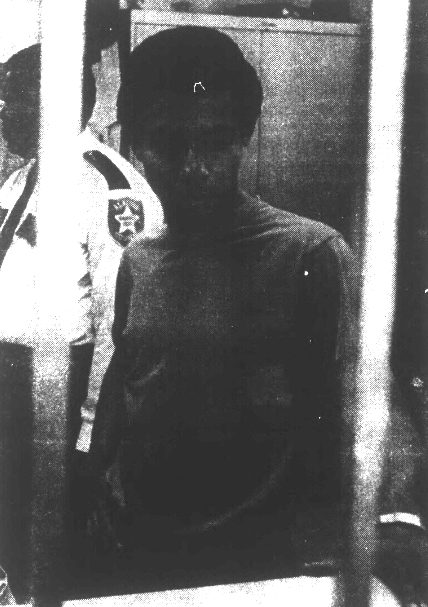
At high noon, the police stormed in. En masse, they arrested the students and herded them outside of Tigert Hall and into buses, like cattle being corralled into a crowding tub.
Duncan climbed into the bus in disbelief. The shock of being arrested sunk deeper into her chest and down to her gut. She had never thought the protest would escalate like this.
And yet, she still wouldn’t have gone to her next class had she’d known this would happen. She’d be exactly where she was, sitting in that seat on the bus, awaiting whatever fate met her and the 65 other students at the Alachua County Jail.
One by one, the students were asked their names to process their arrests. Some gave fake names. Eurina Shitzin. Aretha Franklin. James Brown. Others gave real names. Sulmarie Duncan.
They were thrown into holding rooms in the jail; they couldn’t all fit in the cells. Boys were put into one room and girls in another. But they were close by and could hear each other. They felt frightened but also exhilarated. The rooms bursted with energy and the sounds of the students singing freedom songs.
Outrage sparks on campus
Back on campus, word of the arrests spread fast, like a relentless fire, inciting sparks in the hearts of thousands of students. They felt anger, disgust, shame.
They flocked to the Plaza of the Americas as student government leaders worked to raise bail money for all those who were arrested. At 2 p.m., Student Body President Steve Uhfelder addressed the crowd before him.
“It’s about time we start to realize that the problem of this campus are not being solved by the existing power structure — and the reason stems from President O’Connell,” Uhfelder said.
He called for O’Connell’s immediate resignation.
Police fired canisters into the crowd. The students began coughing and tearing. And still, many stayed.
Less than a year before, Uhfelder had been in a similar position. He had asked O’Connell for a moratorium on classes to honor the victims of the shootings at Kent State, where National Guardsmen opened fire on campus protests and killed four students. O’Connell refused to pause classes and Uhfelder had organized his own protest. Thousands of students skipped class to attend.
Uhfelder thought O’Connell’s resignation was long overdue. It was clear to Uhfelder where O’Connell stood on the issue of race and as a proxy, the university.
As the crowd size grew over the next half hour, Kip Smith, the secretary of minority affairs, explained what had happened at Tigert Hall earlier that morning.
“The demands we presented have been through every possible committee on this campus and the problems still remain,” Smith said into a bulky microphone. He told the students that these demands were not new; they’d been fighting for them for the past 18 months with little to no progress.

Just before 3 p.m., the crowd ascended those same immense steps at Tigert Hall.
O’Connell’s door was locked this time and body-blocked by university police officers. Protesters filled Tigert Hall and spilled out onto the large steps outside, the reception area too small to hold the 1,500 students.
The room quickly heated up; bodies pressed together to cram closer to the doors and hot breath rose as the crowd shouted in unison, “O’Connell’s got to go! O’Connell’s got to go!”
Uhfelder was allowed past the guards into O’Connell’s office; as student body president, he acted as a mediator between the two sides. The door shut behind him, the shouts of the crowds now muffled as Uhfelder came face to face with O’Connell. O’Connell’s usually composed demeanor had given way to rage. Control them, he yelled. Get them out of the building or he would have them suspended and arrested, too.
In that moment, Uhfelder felt the weight of his job, if just momentarily. At 21, he was still a kid at heart. And here he was, being asked to control his fellow students by a man who despised him.

Outside O’Connell’s office, Uhfelder asked the students to leave the building. Some considered doing so. Others saw him as a traitor and remained firm in their position inside.
By 4 p.m., students started pouring out of the building, some dragged out by the police.
A few students remained.
The hefty doors that had been closed began to open and out emerged the man who’d spent the afternoon hiding behind them.
“To you in the building, if you don’t move out you’re going to be suspended and arrested — you’ve had your warning,” O’Connell announced.
Uhfeldelt thought he had managed to diffuse the situation. To O’Connell and the cops outside, it was not enough.
“O’Connell said he wanted to meet with a small group of concerned citizens in front of his house. Well, we’re a large group of concerned citizens and we’ve come to help him pack.”
David Hoke, a student protester
There were two buses parked behind Tigert, waiting to be filled with arrested students. As more people filtered out of the building, they surrounded the buses and released the air out of the tires. They weren’t going anywhere.
One sheriff’s deputy grabbed a protester to arrest him, but he hesitated and let him go. They couldn’t arrest them all.
The policemen all started to gather in one area and lined up in horizontal rows. Once in formation, they approached the crowd to try and break it up. Altercations erupted. Police fighting students, students fighting police.
That’s when the tear gas came out.
Police fired canisters into the crowd. The students began coughing and tearing. And still, many stayed.
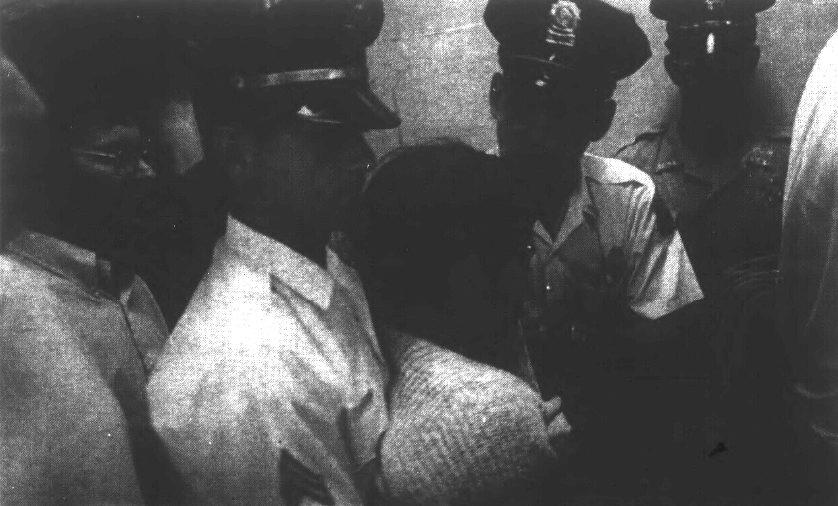
Finding freedom
By late afternoon., the exuberant energy in the jail had died down, and the room had dulled to quiet, restless chatter. The hours of being locked up began to weigh on the students.
Duncan waited with the rest of the women in their room. They never thought the protests would go as far as jail, and now that they were there, they didn’t know what to do. They had been in lockdown for hours and Duncan could feel the anxiety surrounding her.
It wasn’t until 6:15 p.m. that an officer finally appeared and told them they were free to go as long as they could prove they were UF students. Relief. Followed by utter exhaustion.
Duncan returned to her dorm room to find her phone ringing. It was her mother. She had heard the news.
She didn’t know how monumental that day would be; she didn’t know it would incite weeks of protests to follow or that it would be an instrumental event in furthering Black presence at the university.
Duncan reassured her mother of her safety and then settled in for the night. Meanwhile, students were reconvening at the Plaza of the Americas.
Smith, the minority affairs secretary, announced a rally would be held the next day to show O’Connell and the rest of the administration that this wasn’t the end. “The mood of the time will decide,” he said.
Then, together, the students began a march to O’Connell’s house. Accounts vary of how many — some say as many as 1,000.
They took detours through the dorms, recruiting people in the Tolbert and Graham area, as well as Hume Hall, to march with them. They walked up Fraternity Row with the same purpose but with less success. When they arrived at the president’s house, O’Connell wasn’t there. He was at a press conference that had been arranged to explain the events of the day.
One of the protesters, David Hoke, yelled to the crowd: “O’Connell said he wanted to meet with a small group of concerned citizens in front of his house. Well, we’re a large group of concerned citizens and we’ve come to help him pack.”
Five minutes later, O’Connell emerged to greet the crowd.
“Welcome to our lawn,” he began. “I am certain you all understand we’re not going to accomplish anything here tonight. There is nothing you or I are going to accomplish tonight. There is no point in trying to accomplish something — I ask you to leave.”
Someone called out from the crowd, asking if a referendum calling for his resignation would get approved.
No, O’Connell responded. How else could he answer?
He went back inside and then, about a half an hour later, O’Connell and his wife emerged with packed suitcases. They climbed into a university police car and quietly escaped into the night.
The right choice
That night, Duncan had a hard time falling asleep. The day had been heavy with emotions and unexpected consequences. She had a long conversation with her mother.
She didn’t know then how monumental April 15, 1971, would turn out to be; she didn’t know it would incite weeks of subsequent protests or that it would be instrumental in furthering Black presence at the university.
She just knew that on that sunny day, she had made a good choice.
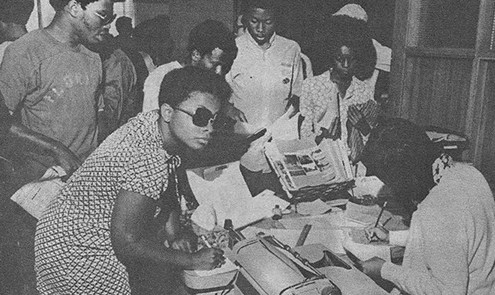
Epilogue

After the events of Black Thursday, as the day came to be known, 123 Black students withdrew from the university, and two Black faculty members resigned, including Roy Mitchell, UF’s first Black administrator.
Black Thursday marked the beginning of a series of solidarity protests from various groups, including UF Law students, the American Federation of Teachers and Student Government.
Of the 66 Black students arrested, 60 had their suspensions lifted 11 days later after continued protests from the student body.
The protests brought about a wave of changes around the university. The Institute of Black Culture was created in the fall of 1971 and was dedicated on Feb. 11, 1972. The University Senate worked to meet the BSU’s demands and increase the number of Black students and faculty.
President O’Connell retired in 1973.
Sulmarie Duncan left UF in 1974 after feeling burnt out in the university system. After a brief break from academia, she returned to school at Saint Leo University to earn a B.A. in psychology and an M.B.A., followed by a Psy.D from University of the Rockies in Denver.
The BSU students had asked that 500 of the 2,800 incoming freshmen be Black, which would raise the percentage of Black students to 17.8% of the UF population. UF still has not met that demand.
According to the most recent census data, 16.9% of Floridians identify as Black or African American. In 2020, only 6.7% of the UF student population was Black.
How this story was reported
WUFT reporter Sarah Breske examined documents she requested from the University of Florida as well as Alachua County. She emailed more than 50 people who attended the protests on April 15, 1971. She interviewed several of them including students Sulmarie Duncan and Steve Uhfelder and photographer Tom Kennedy, who was on the scene that day. Breske read the transcripts of archived interviews with students Joseph McCloud and Sam Taylor. She also read news stories about the protests published in The Alligator.
 Special Report from WUFT News
Special Report from WUFT News
